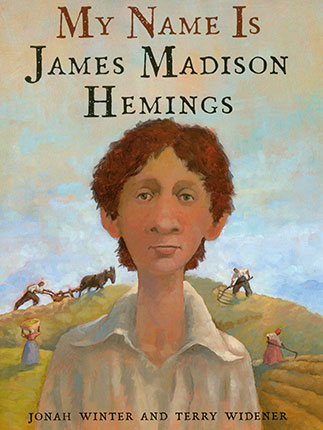| My name is James Madison Hemings Author: Winter, Jonah | ||
| Price: $6.50 | ||
Summary:
A powerful picture book about the child of founding father Thomas Jefferson and the enslaved Sally Hemings.
| Illustrator: | Widener, Terry |
| Accelerated Reader Information: Interest Level: LG Reading Level: 4.90 Points: .5 Quiz: 185289 | Reading Counts Information: Interest Level: 3-5 Reading Level: 5.30 Points: 2.0 Quiz: 69932 | |
Reviews:
Kirkus Reviews (08/15/16)
Booklist (08/01/16)
The Bulletin of the Center for Children's Books (+) (00/11/16)
Full Text Reviews:
Booklist - 08/01/2016 The author of many acclaimed nonfiction books, Winter takes on a neglected part of American history with the story of the son of Sally Hemings and Thomas Jefferson. A chestnut-haired boy, who stares at the reader from the cover, tells his tale in a straightforward yet moving first-person narrative that begins with a terse explanation of slavery. He and his siblings are the children of the man who owns his family. Though Jefferson remains unnamed for most of the book, he is portrayed as a writer, a violinist, a scholar. Sally Hemings is a worker, mending clothes and sweeping floors. For James, life is a series of juxtapositions. He lives and works in the house while he watches others toiling in the field. Jefferson’s granddaughter teaches him to read, but his real education will be learning woodworking. He is a slave, but his father has promised that one day he will be set free. The question James asks near the book’s beginning about his father haunts the rest of the story: “How could I be both his slave and his son?” Terry Widener provides compelling artwork throughout, from a picture of children listening to their mother as she tries to explain their parentage to an ironically pastoral scene of heavenly colored skies and green fields; one has to look closely to see the slaves planting crops. Like Heather Henson’s similar Lift Your Light a Little Higher (2016), Winter’s book raises the question of how far boundaries can be stretched when writing nonfiction. Winter tells us in his lengthy and informative author’s note that his book is “inspired by and partially based” on an 1873 interview with Hemings. Aside from that, Winter continues, “There is limited documentation.” Though he says he has presented Hemings’ story as “historical fiction” (“fictionalized biography” might be a better term), the Library of Congress has given the book a Dewey number of 973.4, placing it on history shelves. Winter’s book is built around the skeleton of a true story and the lives of real people, but incidents, motives, and thoughts are added. For instance, Jefferson gives James a violin, but Winter notes there is no record of who gave James an instrument, how he learned to play, and whether he ever heard his father play. Fictionalized biography is a popular trend in picture-book nonfiction, but it’s worth noting that the target audience will see books in this genre as the truth. They aren’t discerning enough to understand that a book presented as a biography isn’t quite that—and they probably don’t read author’s notes. My Name Is James Madison Hemings tells a story worth telling, and Winter tells it very well. Still, the question lingers: How much leeway does an author have in reshaping a subject’s life to make it fit the narrative? And how do we explain to children that the lines between fiction and nonfiction are not always as clear as they think? - Copyright 2016 Booklist.



